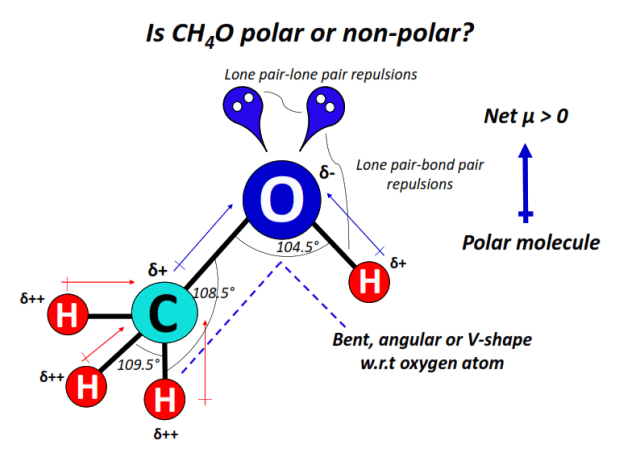Is CH4O polar or nonpolar? – Polarity of CH4O
The question is –
Is CH4O polar or nonpolar?
Answer:
⇒ CH4O is a polar molecule (net µ = 1.7 Debye).
Explanation:
CH4O is the condensed structural formula for methanol (CH3OH). It is polar as it consists of a strongly polar hydroxyl (OH) functional group.
The strong dipole moments of the O-H and C-O bonds do not get canceled equally with the small dipole moments of three weakly polar C-H bonds.
CH4O consists of 3 C-H bonds, 1 C-O bond, and an O-H bond.
Each C-H bond is only weakly polar (almost non-polar as per Pauling’s electronegativity scale), possessing an electronegativity difference of only 0.35 units between the single covalently bonded carbon (E.N = 2.55) and hydrogen (E.N = 2.20) atoms.
The shape of the molecule w.r.t the C-atom in the methyl (CH3) group is tetrahedral.
The C-O bond is moderately polar as per an electronegativity difference of 0.89 units between the carbon and oxygen (E.N = 3.44) atoms.
In contrast, the O-H bond is strongly bonded as per an electronegativity difference of 1.24 units between the oxygen and hydrogen atoms, respectively.
The shape of CH4O or CH3OH is bent, angular, or V-shaped w.r.t the O-atom.
2 lone pairs of electrons present on the oxygen atom lead to strong lone pair-lone pair and lone pair-bond pair repulsions, thus distorting the shape and geometry of the molecule.
Oxygen being strongly electronegative, attracts the C-H bonded electrons in addition to attracting the C-O and O-H bonded electrons.
The charged electron cloud stays non-uniformly spread over the molecule.
The O-atom thus gains a partial negative charge (δ–) while the C-atom gains a partial positive charge (δ+), while each of the terminal H-atoms gains δ++ charges.

It is due to the bent in the above molecular shape that the dipole moments of individually polar bonds stay uncancelled overall.
Consequently, CH4O is overall polar witH a resultant non-zero dipole moment (net µ > 0).
Also, check –
⇒ How to identify polar or nonpolar compounds?
Related Posts
- Is CH3CH2CH2OH polar or nonpolar? – Chemistry QnA
- Is OH2 polar or nonpolar? – Chemistry QnA
- Is ICl4- polar or nonpolar? – Chemistry QnA
- Is OH- polar or nonpolar? – Chemistry QnA
- Is SiS2 polar or nonpolar? – Chemistry QnA
- Is MgCl2 polar or nonpolar? – Chemistry QnA
- Is food coloring polar or nonpolar? – Chemistry QnA
- Is CaCl2 polar or nonpolar? – Chemistry QnA
- Is 2-propanol polar or nonpolar? – Chemistry QnA
- Are double bonds more polar than single bonds? – Chemistry QnA
- Is Octane (C8H18) polar or nonpolar? – Chemistry QnA
- Is S8 polar or nonpolar? – Chemistry QnA
- Is HCO3- polar or nonpolar? – Chemistry QnA
- Is SbF5 polar or nonpolar? – Chemistry QnA
- Is CH3CH2CH3 polar or nonpolar? – Chemistry QnA
- Is NH4Br polar or nonpolar? – Chemistry QnA
- Is HBrO polar or nonpolar? – Chemistry QnA
- Is SeCl2 polar or nonpolar? – Chemistry QnA
- Is IOF5 polar or nonpolar? – Chemistry QnA
- Is GeH4 polar or nonpolar? – Chemistry QnA
- Is KBr polar or nonpolar? – Chemistry QnA
- Is BrF polar or nonpolar? – Chemistry QnA
- Is C2H2Br2 polar or nonpolar? – Chemistry QnA
- Is SCl6 polar or nonpolar? – Chemistry QnA
- Is NO+ polar or nonpolar? – Chemistry QnA
- Is SeH2 polar or nonpolar? – Chemistry QnA
- Is Cl2O polar or nonpolar? – Chemistry QnA
- Is GaH3 polar or nonpolar? – Chemistry QnA
- Is KCl polar or nonpolar? – Chemistry QnA
- Is AlBr3 polar or nonpolar? – Chemistry QnA
- Is NaOH polar or nonpolar? – Chemistry QnA
- Is CH3CH3 polar or nonpolar? – Chemistry QnA
- Is Cyclohexane polar or nonpolar? – Chemistry QnA
- Is NH4NO3 polar or nonpolar? – Chemistry QnA
- Is SCl4F2 polar or nonpolar? – Chemistry QnA
- Is C2H6O polar or nonpolar? – Chemistry QnA
- Is HClO polar or nonpolar? – Chemistry QnA
- Is AsH3 polar or nonpolar? – Chemistry QnA
- Cl2XeF2 polar or nonpolar? – Chemistry QnA
- SeCl6 polar or nonpolar? – Chemistry QnA
About the author
Vishal Goyal is the founder of Topblogtenz, a comprehensive resource for students seeking guidance and support in their chemistry studies. He holds a degree in B.Tech (Chemical Engineering) and has four years of experience as a chemistry tutor. The team at Topblogtenz includes experts like experienced researchers, professors, and educators, with the goal of making complex subjects like chemistry accessible and understandable for all. A passion for sharing knowledge and a love for chemistry and science drives the team behind the website. Let's connect through LinkedIn: https://www.linkedin.com/in/vishal-goyal-2926a122b/
